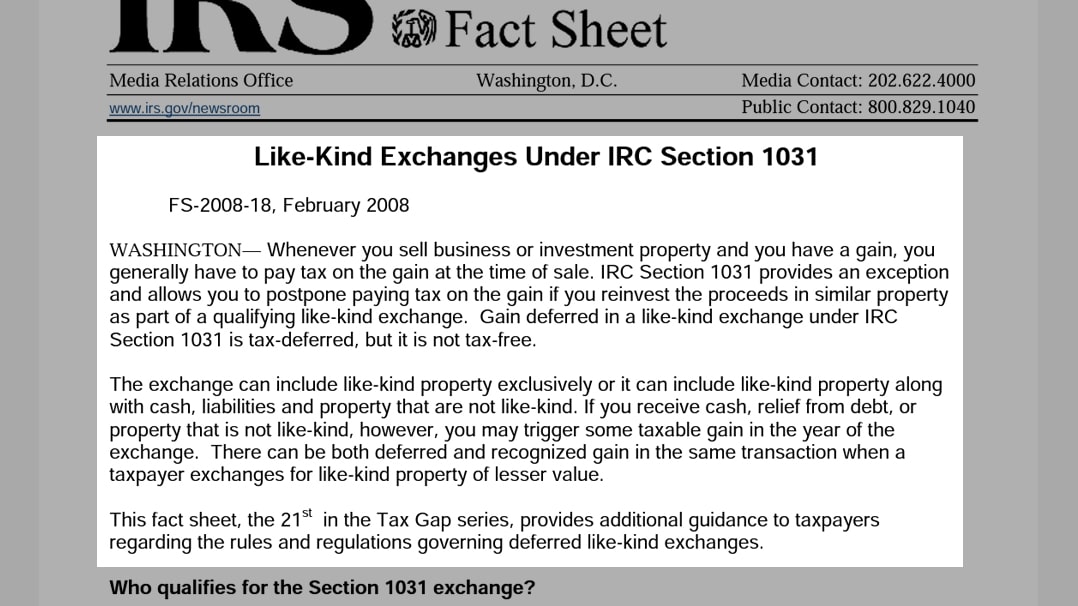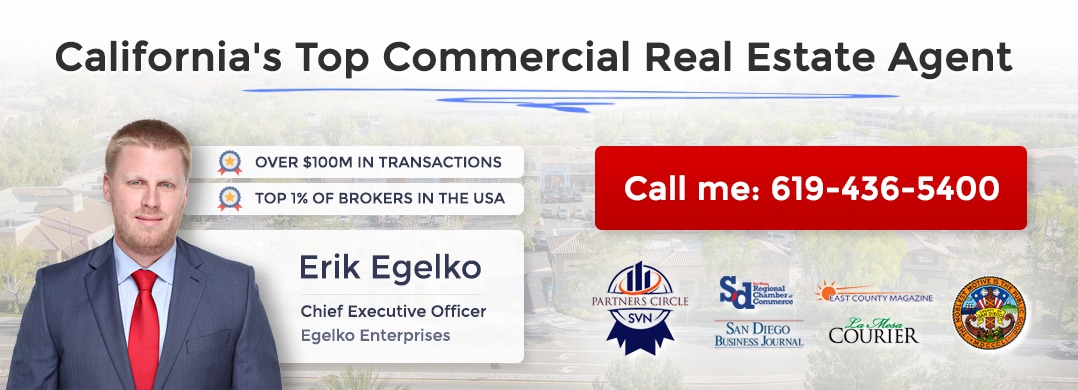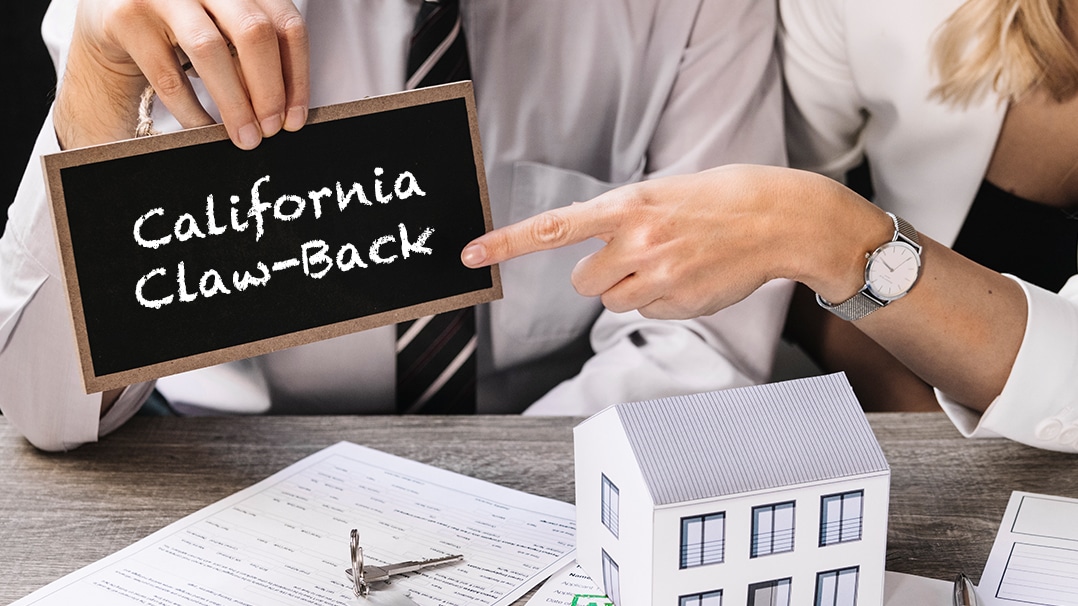
Will California Prop 19 Be Repealed? Here’s The Latest Updates
July 30, 2023
Incentives and Grants for Commercial Real Estate in San Diego
August 11, 2023
Disclaimer: I am not an attorney and this article is not intended as a substitute for advice from the appropriate legal, zoning, financial, construction and/or tax professionals. This information is provided for educational purposes only and is made without warranties or representations
Real estate investors have a lot on their plates, and managing expenses can be a key difference between a property that breaks even and a property that turns a profit. Given that taxes are frequently one of the largest expenses involved in real estate investment, it makes sense to want to find ways to avoid them. In the case of capital gains taxes – accrued when you sell an investment property – they can take a huge chunk of the resulting funds you receive.
One way savvy investors use to avoid (or rather, defer) capital gains taxes is the 1031 exchange. What is it, how does it work, and what do California real estate investors need to know? Read on to find out.
Note before we begin: California’s government uses the 1031 exchange as a frequent battleground, so the rules change seemingly every few years. Always talk to a tax specialist with a focus on real estate for the most up-to-date advice.
What is a 1031 Exchange?
A 1031 exchange is an exchange allowed under federal IRS rules, specifically called IRS Code 1031: “Like-Kind Exchanges.” Form 8824 is used to report these exchanges, with specific rules and regulations to cover it.
California has its own special rules as well, under the Internal Revenue Code section 1031. It’s convenient that it has the same name, right?

In general terms, the idea of a 1031 exchange is simple. If you’re selling a property, you pay capital gains taxes on the profit from the sale. But, if you’re essentially “trading up” by selling the property and immediately buying a similar property to expand or improve your investment, it doesn’t make sense to levy capital gains taxes on what is essentially a trade.
Of course, if this were unrestricted, no one would sell property, and everyone would just set up strings of complicated trades to avoid all of the potential taxes. So, the 1031 provision requires “like-kind” exchanges rather than any property exchanges. This is one of a handful of important restrictions that can make or break your attempt to use a 1031 exchange to defer your capital gains taxes.
Does California Have Special Rules for 1031 Exchanges?
Yes. California has a variety of rules and provisions on 1031 exchanges that make them slightly less broadly useful than they may be in other states. You can still use them, but qualifying for them is a little harder.

In California, to perform a 1031 exchange, your properties – the one you’re selling and the one you’re buying – need to meet certain criteria.
- The properties must be investment properties or business properties.
- The properties cannot be “under development for resale,” i.e., a property bought solely to flip.
- The property you purchase must be of like kind to the property you’re selling.
You also have to jump through some specific hoops to make sure the transaction is not just selling one property and buying another, but rather, a transfer of properties.
What Does Like-Kind Mean?
Like-kind in properties means both properties are investment properties, rather than things like residential homes, houses for flipping, or other non-investment properties. You can’t exchange a vacation home or primary residence for an investment property and still qualify for 1031 exchange deferments.

However, this category is pretty broad, which facilitates a variety of different kinds of transfers. Examples include:
- Selling an apartment building for a rental condo complex.
- Selling a shopping center for a large parcel of raw land.
- Selling developed land for farmland.
- Exchanges between commercial, industrial, or retail properties.
You can also transfer ownership of properties outside of California, though California does have a claw-back clause in their 1031 exchange rules that may make this less feasible for an investor.
The property you receive must be of equal or greater value. This means that only one party in an exchange can defer capital gains with a 1031 exchange.
If there’s a disparity in value between the properties, that disparity cannot be made up with a mixture of other assets, like cash, other property types, or stocks.
Another rule is that the seller of the relinquished property and the buyer of the replacement property must be the same person or party. Your investment LLC works, as does your personal identity as a real estate investor. This rule seems so obvious you might wonder why it’s a rule at all; the truth is, it exists to limit multi-party real estate shuffles that would cause all kinds of bookkeeping nightmares and problems.
All of these rules are broadly meant to remove loopholes and complexity to the 1031 exchange process that would otherwise cause an undue burden on the tax code authorities and the investors who need to fill out all of the paperwork.
Finally, there’s a timeline with strict deadlines for completing a 1031 exchange.
What is the 1031 Exchange Timeline in California?
There are technically two (well, more, but more on that later) kinds of 1031 exchanges: simultaneous and deferred. Simultaneous exchanges don’t have a timeline because they happen immediately. You’ve already selected the property you want to buy in your exchange, you’ve lined up a buyer for the property you’re selling, and you’re ready to press the button and make the swap.

Deferred exchanges are the kind that have a timeline, and there are two specific deadlines you need to know for performing such an exchange in California.
- 45 Days. When you sell your investment property, you have 45 days to select up to three candidates for replacement properties. You have to have the intent to purchase one of them, and if you fail to purchase any of these three, your 1031 exchange is invalid. You also have to notify your intermediary during this window.
- 180 days. This is your final deadline to make the sale and purchase. Both deals need to close by that deadline for the transaction to qualify as a 1031 exchange.
There’s one exception to the 180-day deadline, however. That is in cases where your tax returns are due earlier than the deadline. If you start your 1031 exchange when there are only 100 days between now and the due date for your tax return, you have 100 days rather than 180.
There are no opportunities for extensions or appeals. If you miss the deadline, that’s it; you don’t have a 1031 exchange, and you’ll have a hefty tax bill for the capital gains in the property you sold, regardless of whether or not you had intended to leverage that cash towards the purchase of the new property.
What’s This About an Intermediary?
Part of qualifying for a 1031 exchange in California is that you need to facilitate the deal through an intermediary. This intermediary must be qualified, though many property managers and real estate agents have that qualification, so it’s not a rare thing to find.
The qualified intermediary essentially acts as an escrow service. When you sell your relinquished property, you’re not allowed to take control of the money right away; otherwise, you invalidate the 1031 exchange. Instead, your intermediary holds it and uses it to facilitate the purchase of the replacement property.

The only difficult requirement for your intermediary is that you cannot be your own intermediary, and you cannot use anyone who has worked for you in the past two years. This is to prevent biased exchanges and other exploitations of the process.
What Other Kinds of 1031 Exchanges Exist?
In addition to the simultaneous and deferred 1031 exchanges, there are two other kinds of exchange you might encounter.
The first is the reverse exchange. In a typical 1031 exchange, you sell your property and use the funds to buy a replacement property. In a reverse exchange, you find a deal you can’t refuse and buy the property first, then sell your property to realize the 1031 exchange. These can be tricky to pull off since all of the usual deadlines and rules still apply, but having the liquid funds to buy a property right away can be tough. On the plus side, if you buy multiple properties and then sell one of yours, you have that 45-day window to decide which of the purchased properties is the one you’ll apply to the exchange.


The final kind of exchange is called a construction/improvement exchange. With this exchange, you’re allowed to use equity from the exchange to make improvements to the property. However, there are specific rules for this kind of exchange, making it relatively rare.
What’s the California Claw-Back?
While the term might sound like it applies to a football maneuver, the California Claw-Back is actually a provision in the 1031 exchange system (which is why it’s being covered in this article, of course.)
Put simply, California doesn’t want you to use a 1031 exchange to transfer your ownership of property away from California.
Your capital gains taxes will apply whenever you finally sell your investment property to realize the gains rather than hold and continue to exchange it. Generally, you pay federal taxes, and you pay state taxes that apply to the state where you sold the asset. That’s all simple and fine.

Imagine this situation. You own a property in California, and you want a property in New York. So, you perform a 1031 exchange, selling your California property and buying a New York property of like kind.
In a normal circumstance, if you then sell that New York property to realize the gains, you would be taxed according to New York state taxes. However, the California Claw-Back provision has “flagged” that property. When you sell, you are not only responsible for New York taxes; you’re responsible for California taxes as well.
As if this wasn’t complicated enough, the paperwork “remembers” how much you sold the property for in the original 1031 exchange. You aren’t taxed on the full value of the property or its appreciation, just the increase in value from when you sold it in California. Of course, California doesn’t just “remember” that information; they require you to fill out a form called an Information Return every year, in perpetuity, until you sell the property and realize the tax.
You can, to an extent, get around this by then performing another 1031 exchange back to California, where you’ll then be able to sell that property and pay taxes only in California… assuming the state you’re coming from doesn’t have its own claw-back clause.
Should You Pursue a 1031 Exchange?
Using a 1031 exchange can be a powerful tool to defer capital gains taxes. When done properly, you’re able to leverage the complete proceeds of a sale of a property to improve your portfolio rather than having to earmark some of the proceeds for taxes. The higher basis further helps you snowball your investment into better and better properties, and when it finally comes time to sell and realize your proceeds (for retirement or another substantial shift in life), the proportion you pay in taxes is relatively smaller.
1031 exchanges also facilitate smaller details that can help improve your overall investment portfolio. For example, you can shift into new markets, shift to properties with a greater chance of selling quickly when you want to exit the market, and you can reset your depreciation schedule. All of this can have far-reaching implications.

If you’re an investor and you’re looking to buy, sell, or exchange commercial properties in California, I strongly urge you to reach out and contact me. I’m California’s foremost commercial real estate agent, and my expertise is yours to use if you work with me to find and buy your properties or sell the property you have in preparation for an exchange.
Whether you’re buying, selling, exchanging, or something else, California is a unique market with special considerations for every investor. I’m deeply familiar with the ins and outs, pitfalls, and issues you might encounter, and I’m willing to help you make the best possible deals, so contact me today! Or, if you just have any questions, I’d be happy to answer them!

Erik Egelko is a veteran of the commercial real estate business with a specialized focus on Investment Property Sales. In 2021 and 2022, Erik was the #1 ranked Broker in California for one of the largest CRE Firms as well as ranked in the Top 1% of brokers nationwide. He has extensive experience in a variety of asset types including: Retail Shopping Centers, Medical Office Buildings, Industrial Properties, and Multifamily Apartment Complexes. Over the course of his career, Erik has closed over $100,000,000 of commercial property sales throughout Southern California.



